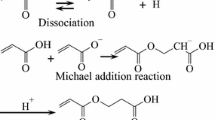Abstract
FROM measurements on the rate of decomposition of nitrous oxide and of several aldehydes, it has recently been suggested1 that the same molecule may under different conditions of pressure decompose homogeneously in the same manner, but with different energies of activation. This is supposed to arise as a result of localisation of the energy of activation in different parts of the molecule. Similar considerations appear to be involved in the thermal decomposition of the rather more complex molecule acrolein, which proceeds homogeneously and at a convenient rate at temperatures in the region of 550° C. It has so far been studied manometrically over the range of initial pressure, 15–600 mm. The products of reaction are carbon monoxide and a mixture of hydrocarbons, the end-point varying slightly with initial pressure.
Similar content being viewed by others
References
Hinshelwood, Proc. Roy. Soc., A, 146, 239, 327, 334, 345 ; 1934.
Author information
Authors and Affiliations
Rights and permissions
About this article
Cite this article
THOMPSON, H., FREWING, J. Thermal Decomposition of Acrolein. Nature 134, 900 (1934). https://doi.org/10.1038/134900a0
Published:
Issue Date:
DOI: https://doi.org/10.1038/134900a0
- Springer Nature Limited





